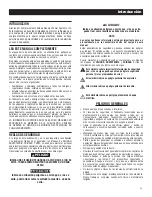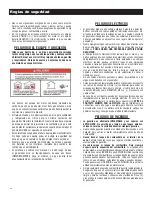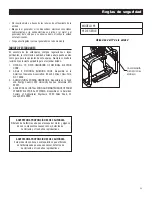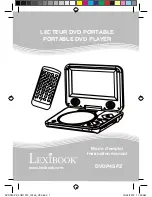
13
• Make sure the piston is at Top Dead Center (TDC) of its
compression stroke (both valves closed). To get the piston
at TDC, remove the intake screen at the front of the engine to
gain access to the flywheel nut. Use a large socket and socket
wrench to rotate the nut and hence the engine in a clockwise
direction while watching the piston through the spark plug hole.
The piston should move up and down. The piston is at TDC
when it is up as high as it can go.
• Insert a 0.002 - 0.004 inch (0.05 - 0.1mm) feeler gauge
between the rocker arm and valve stem. Correct clearance is
when a slight drag is felt when sliding the gauge back and forth.
If the clearance is either excessively loose or tight the rocker
arms will need adjusting.
To adjust valve clearance:
• Loosen the rocker jam nut (Figure 19). Use an 10mm allen
wrench to turn the pivot ball stud while checking clearance
between the rocker arm and the valve stem with a feeler gauge.
Correct clearance is 0.002-0.004 inch (0.05-0.1 mm).
Figure 19 - Valve Clearance Adjustment
NOTE:
The rocker arm jam nut must be held in place as the pivot ball
stud is turned.
When valve clearance is correct, hold the pivot ball stud in place
with the allen wrench and tighten the rocker arm jam nut. Tighten
the jam nut to 174 in/lbs. torque. After tightening the jam nut,
recheck valve clearance to make sure it did not change.
• Install new valve cover gasket.
• Re-attach the valve cover.
NOTE:
Start all four screws before tightening or it will not be possible
to get all the screws in place. Make sure the valve cover gasket
is in place. Replace spark plug.
• Re-attach the spark plug wire to the spark plug.
3.7 LONG TERM STORAGE
It is important to prevent gum deposits from forming in essential
fuel system parts such as the carburetor, fuel hose or tank during
storage. Also, experience indicates that alcohol-blended fuels
(called gasohol, ethanol or methanol) can attract moisture, which
leads to separation and formation of acids during storage. Acidic
gas can damage the fuel system of an engine while in storage.
To avoid engine problems, the fuel system should be emptied
before storage of 30 days or longer, as follows:
• Remove all gasoline from the fuel tank.
Drain fuel into approved container outdoors, away from
open flame. Be sure engine is cool. Do not smoke.
• Start and run engine until engine stops from lack of fuel.
• While engine is still warm, drain oil from crankcase. Refill with
recommended grade.
• Remove spark plugs and pour about 1/2 ounce (15 ml) of
engine oil into the cylinders. Cover spark plug hole with rag.
Pull the recoil starter a couple times to lubricate the piston rings
and cylinder bore.
Avoid spray from spark plug holes when cranking
engine.
• Install and tighten spark plugs. Do not connect spark plug wires.
• Clean the generator outer surfaces. Check that cooling air slots
and openings on generator are open and unobstructed.
• Store the unit in a clean, dry place.
3.8 OTHER STORAGE TIPS
• Do not store gasoline from one season to another.
• Replace the gasoline can if it starts to rust. Rust and/or dirt in
the gasoline will cause problems with the carburetor and fuel
system.
• If possible, store the unit indoors and cover it to give protection
from dust and dirt.
BE SURE TO EMPTY THE FUEL TANK.
• If it is not practical to empty the fuel tank and the unit is to
be stored for some time, use a commercially available fuel
stabilizer added to the gasoline to increase the life of the
gasoline.
• Cover the unit with a suitable protective cover that does not
retain moisture.
NEVER cover the generator while engine and exhaust
area are warm.
Maintenance
Summary of Contents for 005693-1
Page 17: ...15 Notes ...
Page 18: ...16 Notes ...
Page 19: ...17 Notes ...
Page 37: ...35 Notas ...
Page 55: ...53 Remarques ...
















































